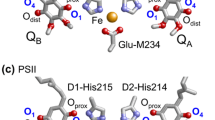Abstract
The transverse organisation of ubiquinone in mitochondrial membranes was investigated by quenching a set of fluorescent fatty acids. We show that the fluorescent moiety of the probes is located at a graded series of depths in the mitochondrial membrane. The probes sense the characteristics of the lipid phase and do not significantly perturb mitochondrial function as measured by the respiratory control ratio and the ADP/O ratio. The anthroyloxy fatty acids are readily quenched by ubiquinone-10. A recently developed method in the analysis of quenching data was used to obtain the subvolume of the membrane within which the quenching interactions are confined. The results indicate that ubiquinone-10 is restricted to two sites in the transverse plane of the membrane: one near the surface and the other close to the bilayer centre. The implications of these findings for the “two-pool” model of ubiquinone organisation are discussed.
Similar content being viewed by others
Abbreviations
- n-AS:
-
n-(9-anthroyloxy) stearic acids (n=6,9,12)
- n-AP:
-
n-(9-anthroyloxy) palmitic acids (n=2,16)
- n-AF:
-
n-(9-anthroyloxy) fatty acids (n=2,6,9,12,16)
- n :
-
nitroxide stearic acids (n=5,16)
- UQ n :
-
ubiquinone-n (n=4,6,10)
- HBHM:
-
heavy beet heart mitochondria
References
Blatt E, Chatelier RC, Sawyer WH (1984) The transverse location of fluorophores in lipid bilayers and micelles as determined by fluorescence quenching techniques. Photochem Photobiol 39: 477–485
Chalpin DB, Kleinfeld AM (1983) Interaction of fluorescene quenchers with the n-(9-anthroyloxy) fatty acid membrane probes. Biochim Biophys Acta 731: 465–474
Chance B, Erecinska M, Radda GK (1975) 12-(9-Anthroyl) stearic acid, a fluorescent probe for the ubiquinone region of the mitochondrial membrane. Eur J Biochem 54: 521–529
Cox GB, Newton NA, Gibson F, Snoswell AM, Hamilton JA (1970) The function of ubiquinone in Escherichia coli. Biochem J 117: 551–562
Degli Esposti M, Bertoli E, Parenti-Castelli G, Fato R, Mascarello S, Lenaz G (1981) Incorporation of ubiquinone homologs into lipid vesicles and mitochondrial membranes. Arch Biochem Biophys 210: 21–32
Encinas M, Lissi EA (1982) Evaluation of partition constants in compartmentalised systems from fluorescence quenching data. Chem Phys Lett 91: 55–57
Ernster L, Lee IY, Norling B, Persson B (1969) Studies with ubiquinone-depleted submitochondrial particles. Essentiality of ubiquinone for the interaction of succinate dehydrogenase, NADH dehydrogenase and cytochrome b. Eur J Biochem 9: 299–310
Estabrook RW (1967) Mitochondrial respiratory control and the polarographic measurement of ADP: O ratios. Methods Enzymol 10: 41–47
Futami A, Hurt E, Hauska G (1979) Vectorial redox reactions of physiological quinones. I. Requirement of a minimum length of the isoprenoid side chain. Biochim Biophys Acta 547: 583–596
Gutman M (1980) Electron flux through the mitochondrial ubiquinone. Biochim Biophys Acta 594: 53–84
Haigh EA, Thulborn KR, Nichol LW, Sawyer WH (1978) Uptake of n-(9-anthroyloxy) fatty acid fluorescent probes into lipid bilayers. Aust J Biol Sci 31: 447–457
Howard RJ, Sawyer WH (1980) Changes in the membrane microviscosity of mouse red blood cells infected with Plasmodium berghei detected using n-(9-anthroyloxy) fatty acid fluorescent probes. Parasitology 80: 331–342
Jacobs EE, Jacob M, Sanadi DR, Bradley LB (1956) Uncoupling of oxidative phosphorylation by cadmium ion. J Biol Chem 223: 147–156
Johnson D, Lardy H (1967) Isolation of liver or kidney mitochondria. Methods Enzymol 10: 94–96
Katsikas H, Quinn PJ (1982) The distribution of ubiquinone-10 in phospholipid bilayers. A study using differential scanning calorimetry. Eur J Biochem 124: 165–169
Katsikas H, Quinn PJ (1983) Fluorescence probe studies of the distribution of ubiquinone homologues in bilayers of dipalmitoylglycerophosphocholine. Eur J Biochem 131: 607–612
Kingsley PB, Feigenson GW (1981) 1H-NMR study of the location and motion of ubiquinones in perdeuterated phosphatidylcholine bilayers. Biochim Biophys Acta 635: 602–618
Kroger A, Klingenberg M (1973) The kinetics of the redox reactions of ubiquinone related to the electron-transport activity in the respiratory chain. Eur J Biochem 34: 358–368
Kutchai H, Huxley VH, Chandler LH (1982) Determination of the fluorescence polarization of membrane probes in intact erythrocytes. Possible scattering artefacts. Biophys J 39: 229–232
Kutchai H, Chandler LH, Zavoico GB (1983) Effects of cholesterol on acyl chain dynamics in multilamellar vesicles of various phosphatidylcholines. Biochim Biophys Acta 736: 137–149
Mitchell P (1961) Coupling of phosphorylation to electron and hydrogen transfer by a chemi-osmotic type of mechanism. Nature (London) 191: 144–148
Mitchell P (1975) Protonmotive redox mechanism of the cytochrome b-c 1 complex in the respiratory chain: protonmotive ubiquinone cycle. FEBS Lett 56: 1–6
Mitchell P (1976) Possible molecular mechanisms of the proton-motive function of the cytochrome systems. J Theor Biol 62: 327–367
Quinn PJ, Esfahani MA (1980) Ubiquinones have surface-active properties suited to transport electrons and protons across membranes. Biochem J 185: 715–722
Sikaris KA, Thulborn KR, Sawyer WH (1981) Resolution of partition coefficients in the transverse plane of the lipid bilayer. Chem Phys Lipids 29: 23–36
Smith AL (1967) Preparation, properties and conditions for assay of mitochondria: slaughterhouse material, small scale. Methods Enzymol 10: 81–86
Szarkowska L (1966) The restoration of DPNH oxidase activity by Coenzyme Q (ubiquinone). Arch Biochem Biophys 113: 519–525
Thulborn KR, Sawyer WH (1978) Properties and locations of a set of fluorescent probes sensitive to the fluidity gradient of the lipid bilayer. Biochim Biophys Acta 511: 125–140
Thulborn KR, Tilley LM, Sawyer WH, Treloar FE (1979) The use of n-(9-anthroyloxy) fatty acids to determine fluidity and polarity gradients in phospholipid bilayers. Biochim Biophys Acta 558: 166–178
Tilley L, Thulborn KR, Sawyer WH (1979) An assessment of the fluidity gradient of the lipid bilayer as determined by a set of n-(9-anthroyloxy) fatty acids (n=2,6,9,12,16). J Biol Chem 254: 2592–2594
Vincent M, de Foresta B, Gallay J, Alfsen A (1982) Nanosecond fluorescence anisotropy decays of n-(9-anthroyloxy) fatty acids in dipalmitoylphosphatidylcholine vesicles with regard to isotropic solvents. Biochemistry 21: 708–716
Author information
Authors and Affiliations
Rights and permissions
About this article
Cite this article
Chatelier, R.C., Sawyer, W.H. The transverse organisation of ubiquinones in mitochondrial membranes as determined by fluorescence quenching. Eur Biophys J 11, 179–185 (1985). https://doi.org/10.1007/BF00257396
Received:
Accepted:
Issue Date:
DOI: https://doi.org/10.1007/BF00257396




